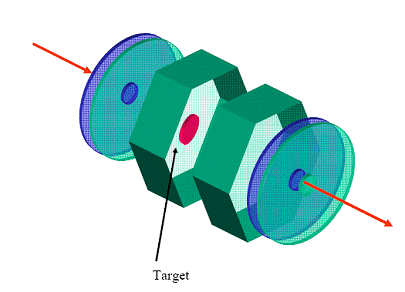Actividad
2. Conceptual design
The proposed experimental set-up will make use of a specific hybrid detector array (gas + solid state detectors) to be developed in nearest future, named the HYbrid DEtector-BALL array. The proposed design will fit the experimental conditions that will be imposed by the beam properties in the Low-Energy Branch of the Super-FRS.
To meet the needs imposed by the physics involved in such a study, different solutions will be studied during he R&D stage of the project foreseen for the period 2007-2009.
In the simplest design the HYDE BALL detector array will incorporate both gas detectors and very compact and highly segmented silicon strip detectors, based on the Double-Sided Silicon Strip Detector (DSSSD) technology. These devices have successfully been used by nuclear physics groups in last few years. The HYDE-Ball array is a conceptual design that relies on the development of an efficient beam tracking system, in particular at the low energy range around 3 MeV/u.
As a preliminary model, the HYDE-BALL array can be composed of several detector units, arranged over a barrel configuration of exagonal cross section and 300mm diameter around the reaction target. Two circular end caps of 300 mm outer diameter and 50mm inner diameter will cover backward and forard scattering angles. A possible configuration might comprise 12 square detector units of 150 mm x 150 mm to be mounted on the barrel walls, togther with 8 circular sectors on each end cap (See figure for an experimental setup).
Each detector unit might be composed of a Gas Detector, able to detect low energy reaction fragments, and two silicon detector units, one DSSSD of 40 um thickness (Energy Loss Detector) and another silicon back counter of 2mm thickness (Stopping Detector). Each silicon DSSSD device is a highly segmented device, composed of 16 strips of 5 mm width at the front side (X direction), and another 16 strips at the back side (Y direction) . This results in a total of 16x16 discrete detector elements, providing energy and position information for every scattered ion and from each detector unit.

In this way it is possible to extract information on the angular distribution of particles, with an angular range between 10º to 70º (forward), 110º to 170º (backward) and angular resolution of Δθ < 2.0º . For low energy scattering events, the combination of the Gas Detector and the Energy Loss detector will provide particle position, charge and mass identification. Higher energy events should be identified using the same technique in combination with the Stop Detector. DSSSD silicon detectors of diferent widths and shapes fitting required specifications are currently produced by several companies (Micron Ltd-UK, Camberra, etc) and used in several experiments at RIB’s facilities elsewhere.




